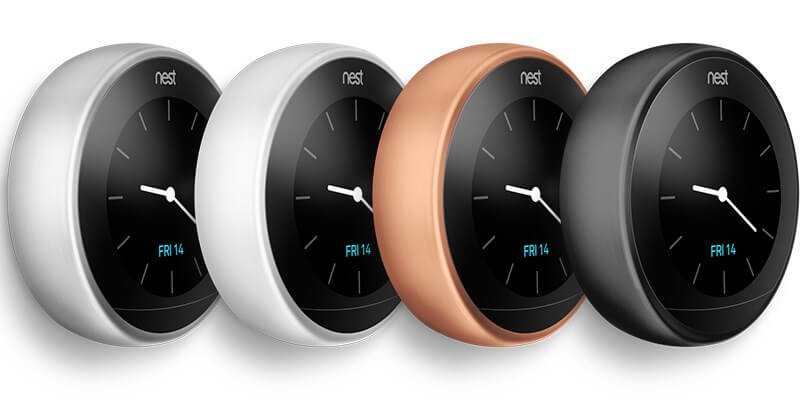Thermostats

-
Energy Star Certified

Nest Learning Thermostat
Nest Learning Thermostat
Ask two different air conditioning & heating contractors how they feel about the Nest Learning Thermostat. You will probably get one that loves it and one that hates it. Nest was the first thermostat manufacturer to market directly to homeowners.
The HVAC contactor who hates it more than likely was afraid that homeowners installing their own thermostat would cut into their business. The one who loves it discovered early that homeowners installing their own thermostat usually leads to a service call!
Magic Touch Mechanical belongs to the “love it” group. In fact, two of the HVAC Systems on our office building in Mesa, AZ are controlled by the Nest Learning Thermostat. Many of our employees have chosen to install the Nest in their own homes as well.
Problems with the Nest Learning Thermostat
Early on, Nest had some problems – self inflicted problems.
- The first problem they had was instant popularity. People rushed out to buy this amazing new programmable thermostat that programmed itself. Nest’s marketing department did a great job of sending the message that this thermostat was so easy to install, you didn’t need to call your local air conditioning company.
That message has now changed to the Nest Pro program where Nest recommends local air conditioning contractors for your installation.
The problem Nest didn’t anticipate is not every air conditioner, heat pump, or furnace is wired the same way. Their instructions to just swap “color coordinated wires” didn’t work a good percentage of the time. The luckier do-it-yourselfers would install their new Nest only to discover it didn’t work. The unlucky people would create an electrical direct-short and burn out the unit’s transformer – a couple hundred dollar mistake.
- The Nest Leraning Thermostat often requires what’s known as a “common” wire. As the Nest does not use batteries, it needs to get power from the AC unit itself. In some cases the nest can “rob” enough power from the unit through other wires. However, in many cases it needs the common wire to get enough power. Now homeowners were left with having no choice but to call an HVAC company to complete the installation.
- The final and perhaps most damaging problem Nest has when they Learning Thermostat hit the scene were bugs and glitches. This led to the main reason some contractor’s went to the “hate it” group. Early on, we had to replace more than a few brand new Nest thermostats that were acting up or just stopped working completely. This even included some of the Nest thermostats in our own office and homes!
The last thing an HVAC company want’s to do is get a “callback” on a product they installed. Call backs cost money, disrupt the work schedule, create an inconvenience for the customer, and leave a bad taste in everyone’s mouth. Granted electronics can fail, it’s a fact of life, but when failures become too common it can break a companies reputation. No contractor wants to be associated with that, and no consumer wants to be the Guinea Pig!
Nest Learning Thermostat 3rd Generation
In 2015, four years after the initial release of the 1st generation, the company released the Nest Thermostat 3rd Generation. In the three years since, it seems like they worked out all the kinks! The failures and bugs seem to be worked out and the problems have dramatically decreased. Enough so that we are very comfortable recommending the Nest as a good smart thermostat option.
We still recommend most people don’t attempt to install the Nest themselves. HVAC components are expensive and damaging them is not worth the risk of saving a few bucks. We all have scissors but that doesn’t make us barbers – no, we do not recommend do-it-yourself haircuts either!
Nest Thermostat 3rd Generation Features
Attractive New Design
The Nest Thermostat 3rd generation display is 40% percent larger than previous versions. The screen is brighter, and has a higher resolution. Now it’s easy to read the temperature from the other side of the room – when set to display always on.
The first two generations while attractive, were stubby. They protruded too far from the wall in our opinion. The 3rd generation Nest Thermostat has a much thinner profile giving it a more modern, sleek look.
Nest Far Sight
In Gen’s 1 & 2 you had to walk right up to the Nest Learning Thermostat to “wake” it. The new model allows you to have the screen off until you approach or keep the display always on. Screen choices include; a digital clock, analog clock, or set temperature. All of which can easily be ready from far away.
Remote Control
As you would expect from any Wi-Fi enabled Smart Thermostat, the Nest can be controlled from your couch or from another country. Even with all of it’s other sensors and automatic settings, we find ourselves using this feature on our own Nest Learning Thermostats quite frequently.
No-Programming Needed / Self Learning
Years ago, the US Department of Energy removed the Energy Star label from all programmable thermostats. Studies, showed that most people did not actually program their programmable thermostat. This was largely due to the fact that older programmable thermostats were complicated and would lose their programming regularly.
The “programming” is what makes these devices more efficient than a traditional set-back thermostat (up/down – on/off).
The Nest Learning Thermostat was the first thermostat to re-earn ENERGY STAR qualification. This was largely do to the fact that it was the first to program itself.
Nest learns what temperature you like and builds a schedule around yours. New studies show that the Nest thermostat saves people an average of fifteen percent on their cooling costs and ten to twelve percent on heating costs. With energy savings like that, the Nest can pay for itself in record time.
Furnace Heads-Up
Modern gas furnaces contain a safety feature called automatic shutoff. This safety device turns the unit off if it exceeds safe temperatures. When the Nest detects the auto-shutoff device is tripping it displays a “heads up” warning on the screen as well as in the Nest App.
Auto Away
Nest’s built in sensors can determine when nobody is home and automatically adjust to save energy. Not to worry if you have pets that stay home all day – this feature can be easily disabled.
New Color Choices
Copper is the new black! Okay, maybe copper doesn’t match your decor or tastes but you have options. The Nest 3rd generation can take on a number of looks by easily changing the outer ring or dial, Options include stainless steel, copper, black and white.